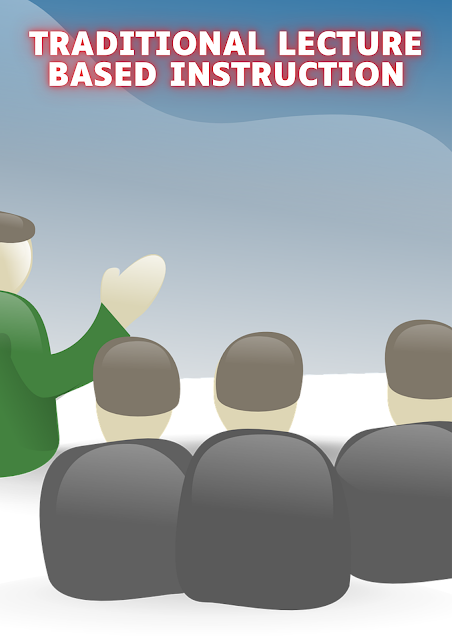Traditional Lecture-Based Instruction
Traditional lecture-based instruction has been a cornerstone of education for centuries, providing a structured method for disseminating knowledge. Despite the emergence of active learning strategies, digital tools, and experiential learning, lectures remain widely used in educational institutions worldwide.
The Structure of Traditional Lecture-Based Instruction
A traditional lecture is typically a teacher-centered method where an instructor delivers information to a passive audience. The core elements include:
Instructor-Led Delivery: A subject-matter expert presents content in a structured format.
One-Way Communication: Students primarily receive information rather than actively engaging.
Fixed Curriculum: The syllabus and topics are predetermined, ensuring consistency across learning sessions.
Minimal Interaction: While some lectures allow for questions and discussions, student participation is often limited.
Advantages of Lecture-Based Instruction
Traditional lectures have persisted due to several benefits backed by research and historical evidence.
1. Efficient Knowledge Transmission
Lectures allow a single instructor to deliver information to a large group of students, making them an efficient method for covering extensive material quickly. Research in Educational Research Review (2018) found that lecture-based methods are highly effective for conveying foundational knowledge and theoretical concepts.
2. Structured Learning Environment
Lectures provide a well-organized learning framework, reducing ambiguity and ensuring that all students receive the same core information. Studies by The Journal of Higher Education (2020) indicate that structured environments promote better content retention and discipline in students.
3. Cost-Effective and Scalable
Compared to interactive or technology-intensive methods, lectures require fewer resources. According to The Economics of Education Review (2019), lecture-based teaching remains the most economical instructional model for large classrooms.
4. Instructor Expertise and Authority
Students benefit from direct interaction with subject-matter experts, gaining insights that may not be available through self-directed study. Research in Teaching and Teacher Education (2021) highlights that instructor presence in traditional lectures enhances motivation and engagement.
Limitations of Lecture-Based Instruction
Despite its benefits, lecture-based teaching has limitations that can impact learning outcomes.
1. Passive Learning and Limited Engagement
Lectures primarily encourage passive learning, reducing opportunities for student participation. A meta-analysis in Active Learning in Higher Education (2020) found that passive learning environments result in lower retention rates compared to interactive teaching methods.
2. One-Size-Fits-All Approach
Lectures are designed for mass instruction and do not cater to individual learning needs. Research in The Journal of Educational Psychology (2019) suggests that personalized and adaptive learning techniques yield higher academic performance.
3. Reduced Critical Thinking and Problem-Solving Skills
Since traditional lectures focus on information delivery rather than application, they may not effectively develop critical thinking and problem-solving skills. A study in Science Education (2018) found that interactive learning strategies significantly enhance problem-solving abilities.
4. Short Attention Span Challenges
Modern students often struggle to maintain attention for long periods. Studies in Cognitive Science (2020) reveal that student engagement declines sharply after 20 minutes of continuous lecturing.
Enhancing Traditional Lectures for Improved Learning Outcomes
To address these limitations, educators can integrate various strategies to make lectures more engaging and effective.
1. Incorporating Active Learning Techniques
Blending lectures with active learning techniques such as:
Think-Pair-Share: Encourages discussion and peer learning.
Case Studies and Problem-Based Learning: Applies knowledge to real-world scenarios.
Interactive Q&A Sessions: Promotes engagement and knowledge retention.
2. Utilizing Technology and Multimedia
Digital tools, such as interactive presentations, videos, and simulations, can enhance engagement. A study in Educational Technology Research and Development (2021) found that multimedia-enhanced lectures increase information retention by 30%.
3. Encouraging Student Participation
Allowing students to ask questions, participate in discussions, and engage in group activities fosters a more interactive learning environment. Research in The Journal of Active Learning (2020) supports the idea that student participation improves comprehension.
4. Implementing Formative Assessments
Periodic quizzes, reflection assignments, and in-class exercises help gauge student understanding and reinforce learning. A meta-analysis in Assessment in Education (2019) highlights that formative assessments improve academic performance by 25%.
Comparing Traditional Lectures with Alternative Instructional Methods
| Method | Strengths | Weaknesses |
|---|---|---|
| Traditional Lectures | Efficient, cost-effective, expert-driven | Passive learning, limited engagement |
| Flipped Classrooms | Encourages self-paced learning, interactive discussions | Requires strong student motivation, time-intensive |
| Project-Based Learning | Enhances problem-solving and creativity | Resource-intensive, may lack theoretical depth |
| Hybrid Learning | Combines flexibility and structured learning | Technology dependency, requires instructor adaptation |
Conclusion
Traditional lecture-based instruction remains a fundamental teaching method due to its efficiency, structure, and cost-effectiveness. However, research suggests that passive learning, limited engagement, and one-size-fits-all approaches may hinder optimal learning outcomes. By integrating active learning strategies, technology, and student participation, educators can enhance traditional lectures, making them more effective in the modern educational landscape. As the field of education continues to evolve, a balanced approach that combines traditional lectures with innovative teaching methods can maximize student success.
References
Educational Research Review (2018). Effectiveness of Lecture-Based Teaching.
The Journal of Higher Education (2020). Structured Learning Environments and Retention.
The Economics of Education Review (2019). Cost-Effectiveness of Lecture-Based Instruction.
Teaching and Teacher Education (2021). The Role of Instructor Presence in Engagement.
Active Learning in Higher Education (2020). The Impact of Passive Learning on Retention.
The Journal of Educational Psychology (2019). Personalized Learning Approaches.
Science Education (2018). Critical Thinking and Active Learning Strategies.
Cognitive Science (2020). Attention Span in Lecture Settings.
Educational Technology Research and Development (2021). Multimedia Integration in Lectures.
Assessment in Education (2019). The Role of Formative Assessments in Learning.
By embracing a hybrid model that merges traditional lectures with interactive elements, educators can create a more dynamic and effective learning experience for students.









0 Comments